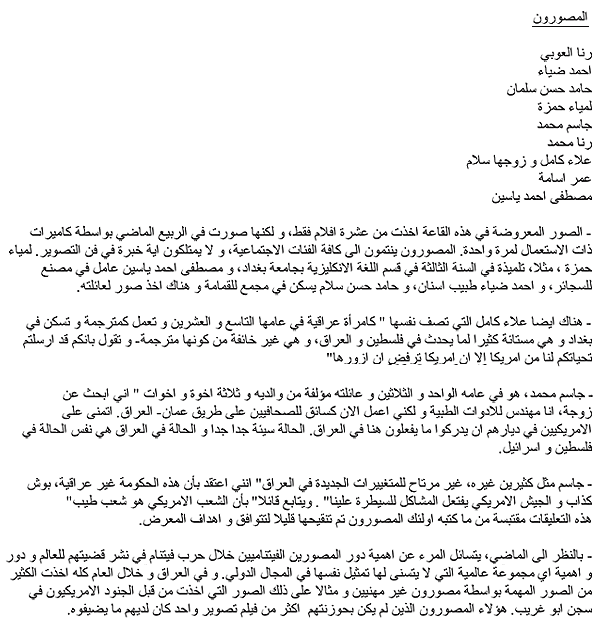 |
THE PHOTOGRAPHERS
Rana Al-Auby
Ahmed Dhiya
Hamed Hasan Salman
Limea Hamza
Jassim Mohammad
Rana Mohammad
Alaa Kamel and her husband Salam
Omar Usama
Mustafa Ahmed Yaseen
The photographs on these walls were taken from only ten rolls of film,
all made this past spring with disposable cameras. The photographers
themselves are civilians coming from a variety of walks of life, none
having to do with taking pictures: Limea Hamza, for example, is a
student in her third year at the English Department of the University
of Baghdad, Mustafa Ahmed Yaseen is a cigarette factory worker, Ahmed
Dhiya is a dentist, and Hamed Hasan Salam lives in the garbage dump
where he photographed his family members.
There is also Alaa Kamel, who describes herself as “an Iraqi
women of 29 years old, working as an interpreter, living in Baghdad,
very much upset about what is happening in Palestine and Iraq, never
feel afraid of being a translator.… You sent me greetings from
America but your country wouldn't like to have me like a visitor there.”
Jassim Mohammad is “31 years old with parents and three brothers
and sisters. I am looking for a wife. I am an engineer in medical
instruments but now drive journalists between Jordan and Iraq. I wish
the Americans [at home] could see what they do here in Iraq….
The situation in Iraq now is very very bad because we are now like
Palestine and Israel.…"
He, like many others, is also skeptical of recent changes. "
I do not believe this new government are really Iraqis. Mr. Bush is
a liar and his troops make trouble and conquer.” But he also
says, “I am sure the American people they are a good people.”
The captions are excerpted from texts written by the photographers
themselves, slightly edited for the purpose of this exhibition.
In retrospect, one wonders how photographs by Vietnamese civilians
at the time of the war in their country might have enlightened outsiders,
or by Jews in concentration camps, or by any group not allowed to
represent themselves on the international stage. It has been a year
in Iraq during which many of the most important photographs have been
made by non-professionals, such as those by US soldiers at the Abu
Ghraib prison. These Iraqi civilian photographers, most with no more
than one roll of film, also have something to add.
|
 |
|